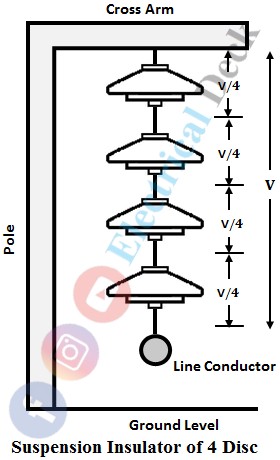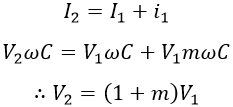Efficiency is a factor that describes the performance of any equipment or device, economic use of equipment, and the extent to which it can be used. Thus it is important to determine the efficiency of a device. The efficiency is given by the ratio of device output to device input.
String Efficiency of Suspension Insulator :
Generally, in overhead transmission lines, we use a number of porcelain discs as an insulator that is arranged in string. This type of insulator is also called a suspension insulator, and the number of insulator discs connected depends upon operating voltage. But due to some factors, this suspension-type string insulator is not fully utilized. Hence the measure of utilization of the string insulators gives the String Efficiency.
The string efficiency of an overhead transmission line insulator is defined as the ratio of voltage across the whole string insulator to that of the product of the number of discs and voltage across the disc nearest to the transmission line conductor.
It can also be defined as the ratio of the spark overvoltage of the complete string to that of the product of the number of discs and the spark over voltage of one disc.
The string efficiency in an ac system cannot be 100% i.e., all the discs in the string insulator are not fully utilized. This is because of the unequal voltage distribution across each disc in the insulator. Let us see the voltage distribution across a string of suspension insulators and its efficiency.
Voltage Distribution Across a String of Suspension Insulators :
A suspension type of insulator consists of a number of insulator discs joined by metallic links. The number of units/discs used in a suspension type insulator depends on the operating voltage. Each disc is made up of the same type of insulating material placed between two metal links and has the same permittivity.
Hence, it forms like a capacitor and is known as mutual capacitance or self-capacitance. If there is only self-capacitance, the voltage distribution is equal throughout the discs and the total voltage across the string is the sum of the individual voltages across each disc as shown below with 4 disc string insulators.
However, practically this is not so i.e., the distribution of voltage across each disc is not uniform. This is because of the effect of capacitance between the metal links and the tower structure. We know that wherever two conducting plates at different potentials, separated with an insulating medium, we get the effect of capacitance. The same effect is felt in the case of suspension-type insulators.
Hence the metal joints and the tower structure are acting as two parallel plates and the air between them is acting as an insulator which is given as an effect of capacitance.
Since the tower structure is at earth potential and the metal links are at some potential. Due to this arrangement, an effect of a capacitor is coming into the picture. This capacitance is called earth capacitance or shunt capacitance.
Now the discs in the suspension insulator are no more in series and thus some leakage current is flowing through the earth capacitor. Hence, the current through each disc is not the same and hence the potential distribution is not equal. The below figure shows the effect of shunt capacitance.
From the above figure, we can see that the shunt capacitance (capacitance between tower and insulator) of each disc is m times the self-capacitance (capacitance of disc), where m is a positive integer.
Distribution of voltage at node 1 can be found by applying KCL, Distribution of voltage at node 2, Similarly, distribution of voltage at node 3, Hence it is observed that the voltage distribution is not uniform across the discs of the string due to the effect of shunt capacitance. The unit near the conductor is impressed with a higher voltage and the voltage goes on decreasing as we move towards the top unit. Due to the unequal distribution of voltage, the string efficiency is always less than 100%.
Significance of String Efficiency :
It is essential to find the string efficiency of transmission line insulators as it suggests the voltage distribution along with each disc of the string insulator.
If voltage distribution is uniform along with the discs of the string insulator, then the efficiency is high and thus each disc of the insulator is fully and equally utilized. This also means that all the discs in the string will experience an equal amount of stress, thereby increasing the life span of the string.
Ideally, the string efficiency is always 100%, but practically it is impossible to achieve 100% string efficiency. By decreasing the ratio of mutual capacitance to self-capacitance, the string efficiency can be improved and distributing the voltage uniformly all across the discs of the string. Also, the increase in the number of discs decreases the string efficiency. Hence string efficiency is high for shorter string insulators.








